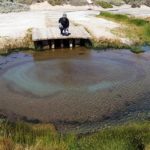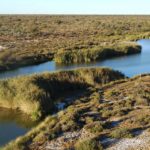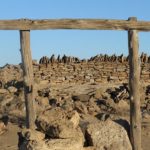Friends of Mound Springs
The Friends of Mound Springs (FOMS) group was established in 2006 and has a total of around 80 members and associates. FOMS has a strong interest in the conservation and management of the mound springs of the Great Artesian Basin and particularly those within Far North South Australia. Membership of FOMS includes a significant number of people with professional knowledge and expertise in mound springs geomorphology, hydrology and ecology.
Unlike the vast majority of Friends groups under the umbrella of Friends of Parks Inc, FOMS’ interests and activities are not focussed on a particular park or parks. In fact the majority of mound springs of direct interest to FOMS are on pastoral lease land.
The Great Artesian Basin (GAB) is an extensive groundwater system covering 22 per cent of the Australian continent, and covering an area of 310,000 square kilometres within South Australia. It has a large storage capacity of 64,900 million megalitres. The Basin is a multi-layered system of water-bearing sandstone aquifers which are up to 3,000 metres deep. Water within the GAB has been dated from several thousand years near sites of recharge to over two million years in the centre of the GAB. That means it may have taken between one and two million years for water entering the recharge areas to reach the central part of the Basin.
Springs form where the deep artesian waters reach the surface along fault lines which cut through the impermeable clays overlying the aquifer beds or where confining beds over the aquifers are either thin or discontinuous
The springs of most interest to FOMS comprise the line of springs along the western margin of the GAB, extending from near Oodnadatta around the western and southern margins of Lake Eyre to Marree and beyond. These include many springs in the Wabma Kadarbu Mound Springs Conservation Park, including the well-known Bubbler and Blanche Cup, west of Lake Eyre South. FOMS also has a strong interest in Dalhousie Springs, which are located within the Basin in Witjira National Park north of Oodnadatta, and which account for a significant proportion of total natural artesian discharge in South Australia. Dalhousie Springs also fall within the field of interest of the Friends of the Simpson Desert Parks.
The spring ecosystems of the GAB are of enormous natural and cultural significance. They are central to the culture of Aboriginal people and vital stepping stones in early European exploration by explorers such as John McDouall Stuart. The routes chosen for the Overland Telegraph line from Adelaide to Darwin as well as the initial Ghan railway to Alice Springs followed the alignment of the springs because of their assured water supplies. They are of huge scientific importance because of their special, often genuinely unique, flora and fauna. Many species of fauna and some flora are found only at the springs. Other species are known as disjunct – that is they occur at the springs but other populations of the same species are hundreds of kilometres away to the south. Mound spring ecological communities are now listed under the Commonwealth Environment Protection and Biodiversity Conservation Act (1999) as an endangered ecosystem.
In its relatively short history, FOMS has had a number of achievements. FOMS’ major project to date has been the establishment of self-guided walks at Strangways Springs, on Anna Creek station, and at Freeling Springs on the Peake, an outstation of Anna Creek. Both sites are of particular interest as they are sites of former repeater stations on the Overland Telegraph line – as well as having the natural and other cultural features referred to above. In total the guided walks traverse more than 6km and FOMS has prepared a walks brochure for each site, as well as a general brochure about the mound springs of SA.
FOMS is now looking more closely at the management of mound springs in a major Commonwealth-funded project in partnership with the Department of Environment, Water and Natural Resources (DEWNR). Since European settlement in the mid-19th century, the mound springs have been subject to a number of influences that have contributed to the loss of many springs and the degradation of others. For South Australian springs, the main disturbances have been:
- Reduced water pressure and flow as a result of widespread extraction from the GAB via artesian bores. Many springs have dried up as a result while others have significantly reduced flow rates. Although there has been an active program to cap uncontrolled bores since the 1970s, there is still much wastage through uncontrolled bores and bore drains – particularly in the GAB in Queensland.
- Grazing, pugging and fouling by livestock and feral animals have had a substantial impact upon spring flora and fauna.
- Weed invasion, the most noteworthy example being proliferation of date palms at Dalhousie Springs.
Paradoxically, at many springs fenced by South Australia’s environment agency in the 1980s, there has been a proliferation of reeds (Phragmites) and, to a lesser extent, rushes (Typha). This proliferation has occurred to the exclusion of other natural spring vegetation with as yet unknown impact upon spring fauna. Both Phragmites and Typha occur naturally in mound springs but their proliferation at protected springs appears to reflect an imbalance of some kind.





